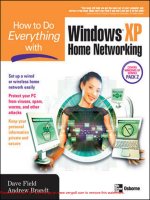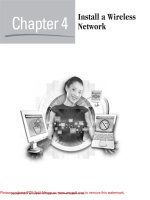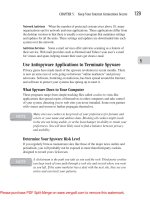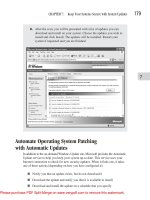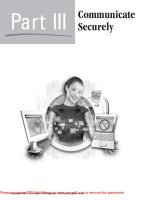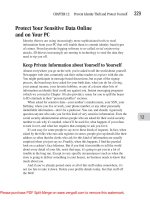Tài liệu How To Do Everything With Windows XP Home Networking- P5 pptx
Bạn đang xem bản rút gọn của tài liệu. Xem và tải ngay bản đầy đủ của tài liệu tại đây (3.21 MB, 50 trang )
CHAPTER 7: Keep Your Systems Secure with System Updates
179
7
Automate Operating System Patching
with Automatic Updates
In addition to the on-demand Windows Update site, Microsoft provides the Automatic
Update service to help you keep your system up-to-date. This service uses your
Internet connection to check for new security updates. When it finds one, it takes
one of three actions (depending on how you have configured it):
■
Notify you that an update exists, but do not download it
■
Download the update and notify you that it is available to install
■
Download and install the update on a schedule that you specify
6.
After the scan, you will be presented with a list of updates you can
download and install on your system. Choose the updates you wish to
install and click Install. The updates will be installed. Restart your
system if requested and you are finished.
Ill 7-7
Please purchase PDF Split-Merge on www.verypdf.com to remove this watermark.
180
How to Do Everything with Windows XP Home Networking
How Automatic Updates Work
Automatic Updates uses a service called Background Intelligent Transfer Service
(BITS) to connect to servers at Microsoft to check for and download updates. BITS
monitors your use of the Internet connection on your computer and transfers data
only when your connection is idle. This use of idle time ensures you do not see
any degradation of performance while updates are being downloaded.
After updates are downloaded, the installation routine can be configured to apply
the updates automatically at a predetermined time. This time can be set to ensure
updates are applied when you will not be at your system. If a restart is required, the
Automatic Updates service will restart your computer.
Configuring Automatic Updates
Automatic Updates is configured using the System Properties dialog box, found
either by opening the System icon on the Control Panel or by clicking the System
icon in Security Center.
Ill 7-8
Notice the default setting specifies automatic installation of updates. This
configuration setting was enabled in Service Pack 2. Prior to Service Pack 2,
Automatic Updates had to be enabled before it could protect your system.
I recommend you leave the settings as-is for now. This is the configuration chosen
by Microsoft to provide the best protection settings by default.
Please purchase PDF Split-Merge on www.verypdf.com to remove this watermark.
CHAPTER 7: Keep Your Systems Secure with System Updates
181
7
Pundits used to recommend varying the installation times for Automatic
Updates to balance the load on Microsoft’s servers. Before you change the
installation time, consider that this is only the time the update will be
applied. The download happens whenever you have idle time on your
Internet connection. If you need to change the setting, choose a time that
your system will be powered on but not in use.
Automatic Updates Settings
The options for installation of updates give you the opportunity to customize it to
suit your needs. We will describe each one and give an example of where it might
be used.
Automatic (Recommended) This setting is recommended by Microsoft because it
ensures updates will be downloaded and installed without user intervention. This is
especially important for those who are not aware their systems need protection.
In the past, systems were compromised simply because their owners did not know
security was an issue. Now these systems are protected by default, and often without
the user’s knowledge.
This setting is also a good basic setting for most configurations. When an update
is available, you will receive notification via a small pop-up message from the
Automatic Updates service. You may choose to install the update immediately or
wait for the automatic installation process to perform the installation.
Service Pack 2 made another change to updates that causes them to be
applied any time the system is shut down. Even if you choose to automatically
install updates, they will be applied any time the system is shut down
regardless of schedule. This ensures they will not be missed if the system is
powered off at the time they were to be installed.
Download Updates for Me… This setting will still download the update and notify
you when it is available, but it will not automatically perform the installation.
Some prefer this option because it allows them to personally ensure the updates
are applied. Others prefer it because they can ensure updates happen while their
systems are powered on. The change brought about by Service Pack 2 to install
updates any time a system is shut down eliminates the need for this, but the setting
remains for those who prefer it.
Please purchase PDF Split-Merge on www.verypdf.com to remove this watermark.
Notify Me… This option will look for updates and notify you when they are available.
This is for those who may be on such a slow connection that they would rather wait
until they get to the home office before they start the download.
Turn off Automatic Updates Please don’t. Some experienced users leave updates
off, but it requires a good deal of discipline to keep up with patching manually.
At least getting notification of the availability of a patch is better than letting your
guard down once and getting “wormed.”
182
How to Do Everything with Windows XP Home Networking
Verify Your Automatic Updates
Are Being Applied
When your system automatically installs updates, it can be like the proverbial
tree falling in the forest. How do you know they are applied when you are not
there to witness it?
When Automatic Updates receives an update, it logs the receipt in the System
Log. You can view this event by opening Event Viewer. Right-click My Computer
and click Manage. You will see the Computer Management console. Expand
the Event Viewer and select System.
Ill 7-9
Please purchase PDF Split-Merge on www.verypdf.com to remove this watermark.
CHAPTER 7: Keep Your Systems Secure with System Updates
183
7
Maintain Microsoft Applications with Updates
In addition to updates to the Windows XP operating system, Microsoft provides
updates to the applications they produce. These updates can be for performance
issues with the applications, security vulnerabilities in the application, or feature
sets added to the application after its initial release. In this section we will show
you where to look for updates for your Microsoft applications.
Locate and Download Updates
for Microsoft Applications
For those applications bundled into Windows, you will receive updates via Windows
update and Automatic updates. For any other applications, you can find updates at
the Microsoft Downloads site located at www.microsoft.com/downloads. This web
site maintains a complete list of all Microsoft applications and lets you search for
updates for them.
Look for events titled “NtServicePack.” The details of the event will give details
about which update has been applied.
Ill 7-10
Please purchase PDF Split-Merge on www.verypdf.com to remove this watermark.
184
How to Do Everything with Windows XP Home Networking
Ill 7-11
You can select the product you want to download updates for and get a list of
all security, performance, and feature updates available for that product. The list
can be sorted by popularity, title, or date of release.
Ill 7-12
Please purchase PDF Split-Merge on www.verypdf.com to remove this watermark.
CHAPTER 7: Keep Your Systems Secure with System Updates
185
7
When you select a patch, you will be presented with a screen detailing what
the patch is intended to fix and providing installation instructions for installing the
patch.
Ill 7-13
After clicking the Download button, you will begin downloading the patch.
Follow the instructions to complete the installation.
Use Internet Explorer to Download Office Updates
The Microsoft Office application suite consists of many different Microsoft
applications bundled into a comprehensive suite for interoperability and—let’s
face it—marketing. Keeping these applications patched would be a Herculean task
if there weren’t some way to help automate the process.
Please purchase PDF Split-Merge on www.verypdf.com to remove this watermark.
Enter Office Update.
Ill 7-14
In the same way Windows Update finds and installs patches for Windows XP
and its bundled applications, Office Update finds and installs patches for the
Microsoft Office suite of applications. Visitors to
will be presented with an ActiveX application very similar to the one used at Windows
Update. Using the application, they will scan their computer for installed updates
and download those they do not have.
186
How to Do Everything with Windows XP Home Networking
Use Office Updates to Install
Microsoft Office Updates
The process of installing Office Updates is very similar to that of installing
Windows Updates. The Office Update application is an ActiveX control that
must be approved for installation just as Windows Update must be.
Please purchase PDF Split-Merge on www.verypdf.com to remove this watermark.
CHAPTER 7: Keep Your Systems Secure with System Updates
187
7
Ill 7-15
Ill 7-16
After the ActiveX control loads, it begins scanning your Office Applications
for necessary updates.
Ill 7-17
After determining which updates are needed, the application displays a list
that you can choose from. A download size and an estimated download time
are given. You may choose not to install all updates at once. If you unselect
some, they will appear next time you use Office Update.
Please purchase PDF Split-Merge on www.verypdf.com to remove this watermark.
188
How to Do Everything with Windows XP Home Networking
Ill 7-18
Office Updates then launches the Office Update Installation Wizard. This
presents you with an End User License Agreement (EULA).
Ill 7-19
Please purchase PDF Split-Merge on www.verypdf.com to remove this watermark.
CHAPTER 7: Keep Your Systems Secure with System Updates
189
7
After reading and accepting the EULA, you will see a final confirmation
screen.
Ill 7-20
After you accept the selections, the download and installation process begins.
Ill 7-21
Please purchase PDF Split-Merge on www.verypdf.com to remove this watermark.
190
How to Do Everything with Windows XP Home Networking
Maintain Non–Microsoft Application Security
Applications not produced by Microsoft are not immune to their own security
problems. After listing the applications on your computer, do a quick Google
search for the application name and the word vulnerability or the word exploit.
You will get pages with information related to any known vulnerabilities your
application may be prone to.
Locate Security Updates for Non-Microsoft Software
There are many places to look for information related to vulnerable applications.
Hopefully you gain the ability by reading this book to know about these before the
attackers do.
After installation, you will see the Installation Results page. Check the status
of the installation to ensure there were no errors during the download and
installation process.
Ill 7-22
Please purchase PDF Split-Merge on www.verypdf.com to remove this watermark.
CHAPTER 7: Keep Your Systems Secure with System Updates
191
7
In this section we will describe sources of information on vulnerabilities and
how to use them. Among these are the Common Vulnerabilities and Exposures (CVE)
list, the Security Focus web site, and the web site of the software manufacturer.
Use the Common Vulnerabilities and Exposures list
There are many lists that track vulnerabilities, but perhaps the best known and
most widely used is the Common Vulnerabilities and Exposures (CVE) list
(www.cve.mitre.org) maintained by the Mitre Corporation and funded by the U.S.
Department of Homeland Security. This list of vulnerability advisories contains all
known vulnerabilities reported to the CVE Editorial Board, a group of representatives
from industry organizations that must agree that the vulnerability merits listing on
the CVE list.
Ill 7-23
Please purchase PDF Split-Merge on www.verypdf.com to remove this watermark.
Listed vulnerabilities include a list of references to additional information on the
vulnerability. Among these references you will usually find information on how to
fix the vulnerability.
Security Focus and the Bugtraq Mailing List
Security Focus maintains an extensive list of known vulnerabilities on their web
site (www.securityfocus.com) and distributes notifications of vulnerabilities via
their Bugtraq mailing list. This service interfaces with the CVE and assigns CVE
numbers to listed bugs and notices when applicable. The online vulnerability database
is searchable by product name and is a very good way to locate information about
your products.
Ill 7-24
192
How to Do Everything with Windows XP Home Networking
Please purchase PDF Split-Merge on www.verypdf.com to remove this watermark.
CHAPTER 7: Keep Your Systems Secure with System Updates
193
7
The Security Focus database also lists the solution for each vulnerability as
soon as it is available. The solution will be either information on locking down the
application or information on where to obtain a patch for the vulnerability.
Ill 7-25
Vendor Web Sites
Responsible vendors will make you aware of vulnerabilities and patches on
their web sites. The only problem with this is that they will (understandably)
not put it on the home page. You will probably have to locate the product
support page for your product to find the information you need. You are often
better off using a service like Bugtraq and following a link to the vendor’s fix
from there.
Please purchase PDF Split-Merge on www.verypdf.com to remove this watermark.
Apply Security Updates for Non-Microsoft Software
Security fixes and updates take on a number of forms. Sometimes it is an
executable program. At other times, it will be a configuration change or a single
file to download and copy to a specific location. Be sure they come from a reliable
source, and scan them for viruses before applying them to your system.
Installation of updates to these applications is no more difficult than installing
application updates from the Microsoft Downloads site, you will just have to be
certain to read the instructions thoroughly and be sure you understand what they
are doing before you attempt to fix the application. If you have any questions, ask
the vendor for help installing the update.
194
How to Do Everything with Windows XP Home Networking
Please purchase PDF Split-Merge on www.verypdf.com to remove this watermark.
Chapter 8
Set Up an Effective
Antivirus Solution
Copyright © 2004 by McGraw-Hill Companies. Click here for terms of use.
Please purchase PDF Split-Merge on www.verypdf.com to remove this watermark.
How to…
■
Distinguish between virus, worm, and Trojan horse attributes
■
Evaluate antivirus solutions
■
Install and configure an antivirus solution
■
Select and use alternative antivirus solutions
T
hus far, we have helped you build a network and outfit it with defenses against
direct attacks. It is time now to give your network an immune system. Virus-
like programs flood the Internet continually, looking for unprotected hosts to infect.
Infected hosts become carriers for these digital organisms, further spreading them
into corporate networks, private networks, and home networks.
In this chapter we will define virus behavior and help you select the antivirus
solution that works best for your home network.
The Role of Antivirus Solutions and Services
From the first computer virus in 1975 to the mass-mailing viruses of today, there
has been a game of cat and mouse between virus authors and antivirus vendors.
Authors of computer viruses have used techniques ranging from simply writing
bits of the virus into program files to creating advanced viruses capable of updating
themselves from Internet servers.
Antivirus vendors have not rested either, developing sophisticated methods of
detecting and cleaning virus infections. Modern antivirus programs can be described
as digital immune systems, capable of adapting to new strains of viruses and defeating
them.
Viruses, Worms, and Trojan Horses
In The Art of War, Sun Tzu wrote, “Know your enemy....” It is important to know
what threats exist in the Internet to know best how to protect your networks and
PCs from them. In this section we will describe the traits of viruses and virus-like
malicious applications. We will describe the methods each use to infect your
computers, and explain why each is a particular threat to your home network. After
that, we will show you how to select an antivirus application that will help protect
your systems from these threats.
196
How to Do Everything with Windows XP Home Networking
Please purchase PDF Split-Merge on www.verypdf.com to remove this watermark.
Identify Virus Activity
Computer viruses are self-replicating programs that infect programs and files in
computers and copy themselves into other files on the host system, thus spreading
their infection. They are characterized by the necessity of human action to release
their payload. This is accomplished by someone either copying the infected file
onto their system, running infected programs, or opening infected documents. Once
released, the infection is spread to other files on the computer or e-mailed to other
targets using the victim’s address book.
Viruses have employed several methods to avoid detection. Early viruses were
detected because they modified the beginning of an executable file to include their
operating code. Virus scanners were able to detect them by scanning the first few
bytes of each program for patterns of known viruses. Virus writers began just adding
small hooks into the beginning of programs and inserting the virus code into another
part of the program. After this strategy became known, they took to writing viruses
that mutated or morphed (polymorphism) into slightly different versions as they
spread.
Viruses may carry damaging components called payloads that destroy data,
render systems unbootable, or display embarrassing messages to users.
CHAPTER 8: Set Up an Effective Antivirus Solution
197
8
The First Computer Virus
Was Written Almost 30 Years Ago
The first computer virus was developed by a man named John Walker in 1975
as a way to distribute a computer game to UNIVAC computer systems. The
virus, named Pervade, copied the Animal game to systems Mr. Walker never
intended, with copies even ending up on software distribution tapes for new
UNIVAC systems.
The first microcomputer (personal computer) virus was written by a ninth-
grader in 1982. The virus, Elk Cloner, would remain in system memory and
infect floppy disks inserted into the system. After the fiftieth boot from an
infected disk, the virus would display a short poem.
From these beginnings, virus writing escalated to the number one source
of computer annoyances before being supplanted in 2003–2004 by unsolicited
e-mail (spam).
Please purchase PDF Split-Merge on www.verypdf.com to remove this watermark.
Identify Worm Activity
Worms differ from viruses in that they spread without human interaction. Using
vulnerabilities in applications or operating systems, they spread from system to
system, going to work to scan for and infect other systems. Some of the largest
global outbreaks have been the result of worm infections.
Some worms carry payloads to damage data on infected systems; others are
designed only to spread to other systems.
Identify Trojan Horse Activity
Trojan horses may spread through virus or worm mechanisms and are typically
thought of as a particular payload of these pathogens. What characterizes them as
Trojan horses is the resemblance they bear to the mythical Trojan horse of Greek
legend. Like the Trojan horse, they masquerade as helpful programs or information
and act behind the scenes to open back doors into your systems to allow control by
hackers.
Other Virus-Like Malware
Often delivered as the payload of a virus or worm, malicious software such as bot
or zombie programs can make your system an unwilling accomplice in international
cyber attacks. Major Internet sites have been disabled by these attacks due to the
large bot armies that have been amassed by hackers for the purpose of conducting
distributed denial of service (DDoS) attacks. (If you missed Chapter 5, a distributed
denial of service attack is a mass flood of data directed against a particular host
from a large number of zombie systems under the control of a single individual.)
Spyware and spybots are a recent development designed to spy on your surfing
habits, sometimes even logging keystrokes to expose personal secrets that hackers
might find of value. Some also act as spam remailers, using your bandwidth to launch
floods of unsolicited e-mail out over the Internet.
Blended Threats
One of the latest developments that has received some press is known as a blended
threat. This type of attack blends two or more different types of attack into
a comprehensive assault on your system. In this scenario, you might encounter
a worm or a spybot that installs Trojan horse programs or other malware as an
additional payload.
A well-publicized blended threat case is that of the June 2004 release of the
Scob worm, which was designed to infect Microsoft web servers with a JavaScript
program that would attack Internet Explorer web browsers. Internet Explorer would
198
How to Do Everything with Windows XP Home Networking
Please purchase PDF Split-Merge on www.verypdf.com to remove this watermark.


